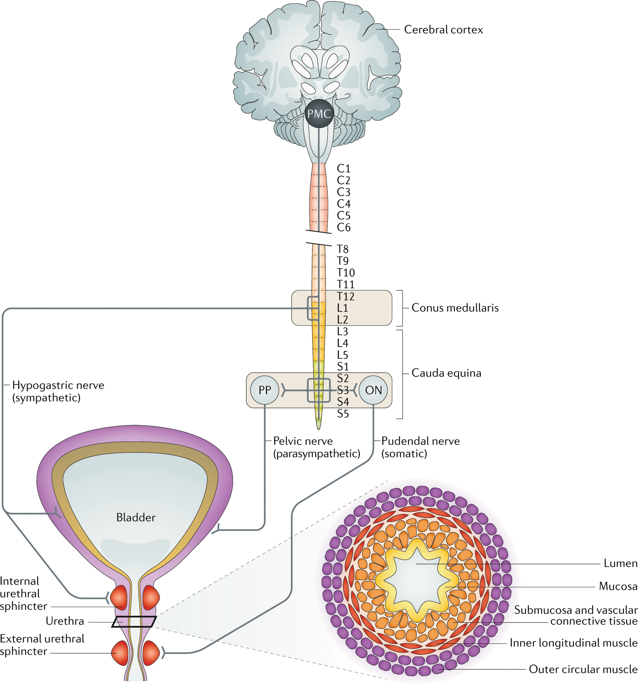当前位置:
X-MOL 学术
›
Nat. Rev. Urol.
›
论文详情
Our official English website, www.x-mol.net, welcomes your
feedback! (Note: you will need to create a separate account there.)
Regenerative medicine and injection therapies in stress urinary incontinence.
Nature Reviews Urology ( IF 12.1 ) Pub Date : 2020-01-23 , DOI: 10.1038/s41585-019-0273-4 Christopher J Hillary 1, 2, 3 , Sabiniano Roman 2 , Sheila MacNeil 2, 3 , Wilhelm K Aicher 3, 4 , Arnulf Stenzl 3, 4 , Christopher R Chapple 1, 3
Nature Reviews Urology ( IF 12.1 ) Pub Date : 2020-01-23 , DOI: 10.1038/s41585-019-0273-4 Christopher J Hillary 1, 2, 3 , Sabiniano Roman 2 , Sheila MacNeil 2, 3 , Wilhelm K Aicher 3, 4 , Arnulf Stenzl 3, 4 , Christopher R Chapple 1, 3
Affiliation

|
Stress urinary incontinence (SUI) is a common and bothersome condition. Anti-incontinence surgery has high cure rates, but concerns about mesh tapes have resulted in the resurgence of surgical procedures that involve increased abdominopelvic dissection and morbidity. Injection therapy with urethral bulking agents or stem cell formulations have been developed as minimally invasive alternatives. Many synthetic and biological bulking agents have been trialled, but several have been discontinued owing to safety concerns. The use of Macroplastique and Contigen has the largest evidence base, but, overall, success rates seem to be similar between the various agents and positive outcomes are poorly sustained for more than 6 months. Furthermore, subjective cure rates, although initially high, also deteriorate over time. The available data consistently demonstrate manifestly poorer outcomes for injection therapies than for surgery. Stem cell treatments are thought to functionally regenerate the urethral sphincter in patients with suspected intrinsic sphincter deficiency. Autologous adipose and muscle-derived stem cells seem to be the intuitive cell source, as they are comparatively abundant, can be harvested and cause minimal donor site morbidity. To date, only a few small clinical studies have been reported and most data are derived from animal models. The success rates of stem cell injection therapies seem to be comparable with those of bulking agents.
中文翻译:

压力性尿失禁的再生医学和注射疗法。
压力性尿失禁 (SUI) 是一种常见且令人烦恼的疾病。抗失禁手术治愈率很高,但对网状胶带的担忧导致涉及增加腹盆腔夹层和发病率的外科手术重新流行。使用尿道填充剂或干细胞制剂的注射疗法已被开发为微创替代方案。许多合成和生物填充剂已经过试验,但由于安全问题,一些已停止使用。Macroplastique 和 Contigen 的使用拥有最大的证据基础,但总体而言,各种药物的成功率似乎相似,而且阳性结果难以持续超过 6 个月。此外,主观治愈率虽然最初很高,但也会随着时间的推移而恶化。现有数据一致表明,注射疗法的结果明显比手术要差。干细胞治疗被认为可以在怀疑内在括约肌缺陷的患者中功能性地再生尿道括约肌。自体脂肪和肌肉来源的干细胞似乎是直观的细胞来源,因为它们相对丰富,可以收获并导致最小的供体部位发病率。迄今为止,只有少数小型临床研究被报道,大多数数据来自动物模型。干细胞注射疗法的成功率似乎与填充剂的成功率相当。干细胞治疗被认为可以在怀疑内在括约肌缺陷的患者中功能性地再生尿道括约肌。自体脂肪和肌肉来源的干细胞似乎是直观的细胞来源,因为它们相对丰富,可以收获并导致最小的供体部位发病率。迄今为止,只有少数小型临床研究被报道,大多数数据来自动物模型。干细胞注射疗法的成功率似乎与填充剂的成功率相当。干细胞治疗被认为可以在怀疑内在括约肌缺陷的患者中功能性地再生尿道括约肌。自体脂肪和肌肉来源的干细胞似乎是直观的细胞来源,因为它们相对丰富,可以收获并导致最小的供体部位发病率。迄今为止,只有少数小型临床研究被报道,大多数数据来自动物模型。干细胞注射疗法的成功率似乎与填充剂的成功率相当。
更新日期:2020-01-23
中文翻译:

压力性尿失禁的再生医学和注射疗法。
压力性尿失禁 (SUI) 是一种常见且令人烦恼的疾病。抗失禁手术治愈率很高,但对网状胶带的担忧导致涉及增加腹盆腔夹层和发病率的外科手术重新流行。使用尿道填充剂或干细胞制剂的注射疗法已被开发为微创替代方案。许多合成和生物填充剂已经过试验,但由于安全问题,一些已停止使用。Macroplastique 和 Contigen 的使用拥有最大的证据基础,但总体而言,各种药物的成功率似乎相似,而且阳性结果难以持续超过 6 个月。此外,主观治愈率虽然最初很高,但也会随着时间的推移而恶化。现有数据一致表明,注射疗法的结果明显比手术要差。干细胞治疗被认为可以在怀疑内在括约肌缺陷的患者中功能性地再生尿道括约肌。自体脂肪和肌肉来源的干细胞似乎是直观的细胞来源,因为它们相对丰富,可以收获并导致最小的供体部位发病率。迄今为止,只有少数小型临床研究被报道,大多数数据来自动物模型。干细胞注射疗法的成功率似乎与填充剂的成功率相当。干细胞治疗被认为可以在怀疑内在括约肌缺陷的患者中功能性地再生尿道括约肌。自体脂肪和肌肉来源的干细胞似乎是直观的细胞来源,因为它们相对丰富,可以收获并导致最小的供体部位发病率。迄今为止,只有少数小型临床研究被报道,大多数数据来自动物模型。干细胞注射疗法的成功率似乎与填充剂的成功率相当。干细胞治疗被认为可以在怀疑内在括约肌缺陷的患者中功能性地再生尿道括约肌。自体脂肪和肌肉来源的干细胞似乎是直观的细胞来源,因为它们相对丰富,可以收获并导致最小的供体部位发病率。迄今为止,只有少数小型临床研究被报道,大多数数据来自动物模型。干细胞注射疗法的成功率似乎与填充剂的成功率相当。









































 京公网安备 11010802027423号
京公网安备 11010802027423号